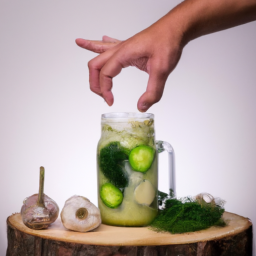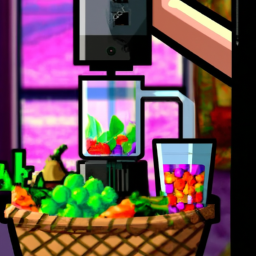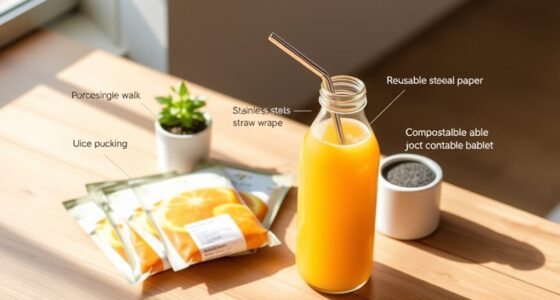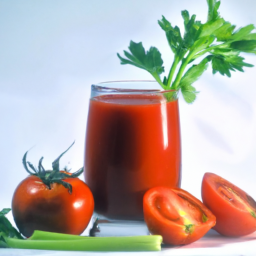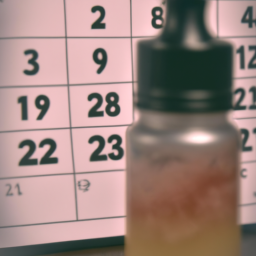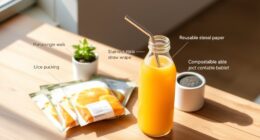I’m totally infatuated with pickles – the sharp, acidic taste combined with their crunchy feel simply captivates me. However, were you aware that it’s possible to create your own pickle brine right in your kitchen? Doing so not only provides an excellent use for any surplus cucumbers, but it also offers an incredible means to infuse a variety of recipes with flavor, ranging from marinades to mixed drinks.
Making pickle juice is a surprisingly simple process, and with just a few ingredients and some basic equipment, you can create your own signature blend that’s perfect for your taste buds.
In this article, I’ll walk you through the process step-by-step, from selecting your cucumbers to straining your finished product.
So grab your apron and let’s get started!
Key Takeaways
- Pickle juice can be made using traditional (fermentation) or quick methods, and should have a balance of vinegar, salt, and sugar.
- Optional flavorings such as garlic and dill can be added to the brine, and apple cider vinegar or honey can be used as alternatives to white vinegar and sugar.
- After combining cucumbers and brine, they should be fully submerged and left at room temperature for a few hours before transferring to a jar and storing in the refrigerator.
- Homemade pickle juice has numerous health benefits, can be used in a variety of ways, and should be savored and not wasted.
Gather Your Ingredients
You’re gonna need some cucumbers, vinegar, salt, and spices if you want to make the perfect pickle juice. The cucumbers should be fresh, firm, and free of blemishes. You can use any type of vinegar, but white vinegar is the most common.
As for spices, dill, garlic, and mustard seeds are popular choices. Don’t be afraid to experiment with different spices to find your perfect blend.
Pickle juice has a variety of uses, from adding flavor to dishes to being a natural remedy for many health issues. Drinking pickle juice can help alleviate muscle cramps, aid in digestion, and even regulate blood sugar levels. It’s also a great way to stay hydrated and replenish electrolytes after a workout.
With all these benefits, it’s no wonder pickle juice has become a popular drink among athletes and health enthusiasts. Now that you know why pickle juice is so great, let’s move on to the next step: choosing your method.
Choose Your Method
Now that you’ve got the cucumbers ready, it’s time to decide which method you’ll use to create that tangy, salty elixir that you crave.
There are two main methods for making pickle juice: the traditional method and the quick method. Let’s weigh the pros and cons of each, and I’ll also share my personal preference.
First up is the traditional method, which involves fermenting cucumbers in a saltwater brine for several weeks. This method produces a complex, nuanced flavor with a slightly sour tang. However, it does require more time and patience than the quick method.
On the other hand, the quick method involves mixing vinegar, water, and salt together and bringing them to a boil. This method is much faster and easier, but the resulting pickle juice may lack the depth of flavor that you would get from fermenting. Personally, I prefer the traditional method for its rich flavor and satisfying tang.
Moving onto the next step, it’s important to sterilize your equipment to ensure that your pickle juice doesn’t spoil.
Sterilize Your Equipment
Before diving into the next step of creating your tangy elixir, it’s crucial to ensure that your equipment is sterile to prevent any unwanted bacteria from spoiling your final product.
There are two primary ways to sterilize your equipment – boiling and chemicals. Boiling is a simple method that involves boiling your equipment in water for about 10 minutes. This method is effective in killing most bacteria and is an excellent way to sterilize mason jars, lids, and other utensils.
On the other hand, chemicals such as bleach or hydrogen peroxide can also be used to sterilize equipment. However, these chemicals can be harmful if not used correctly. Regardless of the method you choose, the importance of cleanliness cannot be overstated.
Ensure that all equipment is thoroughly cleaned before sterilizing to remove any dirt or debris that may affect the sterilization process.
Now that your equipment is sterilized, it’s time to prepare your cucumbers.
Prepare Your Cucumbers
First things first, let’s get those fresh cucumbers washed and ready for their transformation into a deliciously tangy snack. When it comes to choosing cucumbers for pickling, it’s important to select the right type. There are two main types of cucumbers: pickling cucumbers and slicing cucumbers. Pickling cucumbers are shorter and have a bumpy skin, while slicing cucumbers are longer and smoother. Pickling cucumbers are the best choice for making pickle juice since they have less water content and firmer flesh, which results in a crunchier texture.
Once you’ve selected your cucumbers, it’s time to prepare them for pickling. Start by washing them thoroughly and removing any dirt or debris. Then, slice off both ends of each cucumber and cut them into the desired shape and size. The best time to pickle cucumbers is when they are fresh and in season, which is typically from June to September in the United States. With your cucumbers prepped and ready to go, it’s time to move onto the next step: making your brine.
(Note: In the subsequent section, we will discuss how to make your brine, which is an essential component in making pickle juice.)
Make Your Brine
Now that I’ve got my cucumbers ready, it’s time to make the brine for my pickles. The key to a good brine is getting the proportions of vinegar, salt, and sugar just right. I usually go with a ratio of 1:1:1, using equal parts water, vinegar, and sugar, and then adding salt to taste.
Additionally, I like to experiment with optional flavorings, such as garlic, dill, or red pepper flakes, to add some extra kick to my pickles.
Proportions of Vinegar, Salt, and Sugar
To make the perfect pickle juice, you’ll need to balance the vinegar, salt, and sugar like a tightrope walker balancing on a thin wire. The right proportions of these ingredients are crucial for achieving the right flavor and texture. While the classic pickle juice recipe calls for white vinegar, kosher salt, and granulated sugar, there are alternative ingredients you can use depending on your taste preferences and health goals.
Here’s a table to guide you in creating your own pickle juice recipe:
| Ingredient | Purpose | Recommended Amount |
|---|---|---|
| Vinegar | Adds tanginess and acidity | 1 cup |
| Salt | Enhances flavor and preserves the pickles | 1/4 cup |
| Sugar | Balances the sourness and adds sweetness | 1/4 cup |
If you want a healthier version of pickle juice, you can replace the white vinegar with apple cider vinegar, which has been linked to various health benefits such as aiding in digestion and reducing inflammation. You can also use less sugar or substitute it with honey or maple syrup for a more natural sweetness. Keep in mind that the proportions may vary depending on the type and size of pickles you’re using.
To add more depth of flavor to your pickle juice, you can experiment with optional flavorings such as garlic, dill, mustard seeds, or peppercorns. These ingredients can be added to the brine before boiling or steeped in the hot brine for a few minutes before pouring it over the pickles. With the right proportions and flavorings, your homemade pickle juice will not only be delicious but also a healthier alternative to store-bought ones.
Optional Flavorings
Enhance your homemade pickle brine with a variety of optional flavorings, adding depth and complexity to your pickles. Flavor infusion is a great way to take your pickling game to the next level. Here are some recipe variations to consider:
- Dill and garlic: Add fresh dill and garlic cloves to the brine for a classic pickle flavor.
- Spicy: Add red pepper flakes or sliced jalapenos to the brine for a spicy kick.
- Sweet and tangy: Add honey, mustard seeds, and apple cider vinegar for a sweet and tangy flavor.
- Asian-inspired: Add soy sauce, rice vinegar, ginger, and sesame oil for an Asian-inspired flavor.
Experiment with different flavor combinations to find your favorite. Keep in mind that the longer you let the flavors infuse, the stronger the taste will be.
Once you’ve chosen your flavorings, it’s time to combine the cucumbers and brine. To combine cucumbers and brine, simply pour the brine over the cucumbers in a jar or container. Make sure the cucumbers are fully submerged in the brine, and then cover the container tightly.
Store the container in the fridge for at least 24 hours before enjoying your homemade pickles.
Combine Cucumbers and Brine
Mixing cucumbers and brine is the perfect marriage of crispness and tanginess that makes pickle juice so irresistible. Once you have your brine ready, you can start combining it with the cucumbers.
Make sure to use fresh cucumbers and cut them into thin slices or spears depending on your preference. You can also add in any optional flavorings such as garlic, dill, or red pepper flakes to give your pickle juice a unique kick.
As you mix the cucumbers with the brine, make sure that they’re fully submerged to ensure even pickling. Let the mixture sit at room temperature for a few hours to allow the flavors to meld together.
After that, you can transfer the cucumbers and brine to a jar and store it in the refrigerator. With these simple steps, you can make your own delicious pickle juice with all its flavor variations and health benefits.
Store Your Pickle Juice
Now that you’ve combined your cucumbers and brine, it’s time to think about storing your pickle juice.
There are a few options for storing your pickle juice, depending on how long you plan to keep it and how much space you have available.
One option is to store it in the same jar you used to make the pickles, as long as it has a tight-fitting lid.
Another option is to transfer the pickle juice to a clean, airtight container, such as a glass jar or plastic bottle.
Whatever container you choose, make sure it’s clean and dry before adding the pickle juice.
Aside from being a tasty addition to your meals, pickle juice also has some health benefits.
It’s a good source of electrolytes, which can help prevent dehydration and muscle cramps.
It also contains antioxidants and probiotics, which can support a healthy immune system and digestive system.
So, don’t be afraid to drink a little pickle juice straight from the jar or use it as a marinade for your meats.
With your pickle juice stored and ready to use, it’s time to wait for it to develop its full flavor before enjoying it in your favorite dishes.
Wait for Your Pickle Juice to Develop Flavor
Now that I’ve made my pickle juice, it’s time to wait for it to develop flavor. There are two methods I can use: the quick pickle method or the fermentation method.
The quick pickle method involves adding vinegar to the brine to speed up the process, while the fermentation method relies on natural bacteria to create a more complex and flavorful pickle juice.
Quick Pickle Method
To make pickle juice using the quick pickle method, all you need are cucumbers, vinegar, water, salt, sugar, and a few spices. This method is perfect for those who don’t want to wait for the traditional fermentation process to develop the flavors.
Quick pickling is also a great way to use up any extra cucumbers from the garden! There are many uses for pickle juice, including adding it to cocktails, using it as a marinade, or even drinking it on its own for its health benefits.
Pickle juice is known for its ability to help with muscle cramps, aid in digestion, and even lower blood sugar levels. Next, we’ll explore the fermentation method of making pickle juice.
Fermentation Method
Using the fermentation method, cucumbers are left to sit in a brine mixture with spices and left to naturally develop their tangy flavor over time. This process of fermentation involves the growth of beneficial bacteria and the breakdown of sugars in the cucumbers, resulting in a tangy and sour flavor.
Fermentation benefits include the preservation of the cucumbers and the promotion of gut health due to the presence of probiotics.
Alternatively, there are other methods to make pickle juice such as the quick pickle method which involves boiling vinegar, water, and salt then pouring the mixture over sliced cucumbers. However, the fermentation method provides a more authentic and flavorful pickle juice.
To make your own fermented pickle juice, simply leave the cucumbers and brine mixture in a sealed jar for several days to a few weeks until the desired flavor is achieved. Once the fermentation process is complete, the next step is to strain your pickle juice.
Strain Your Pickle Juice
First, grab a strainer and place it over a bowl to catch the pickle juice. Pour the fermented pickle mixture into the strainer, allowing the juice to flow through while leaving the solid pickles behind. Once the majority of the juice has been collected, use a spoon to press down on the pickles in the strainer to release any remaining liquid.
Now that you have your pickle juice, there are many uses for it. Some people like to drink it straight up or use it as a marinade for meat. Others use it to add flavor to cocktails or as a replacement for vinegar in salad dressings. Additionally, pickle juice has been found to have health benefits such as aiding in digestion, relieving muscle cramps, and reducing hangover symptoms. So go ahead and enjoy your homemade pickle juice in whichever way you prefer!
Enjoy Your Homemade Pickle Juice!
Now that you’ve got your delicious homemade pickle juice, go ahead and savor every drop of it! Not only is it a great way to use up leftover pickle brine, but it also has numerous health benefits and creative uses.
Firstly, pickle juice is high in electrolytes and antioxidants, making it a great post-workout beverage to help replenish your body and reduce inflammation. It can also help alleviate muscle cramps and regulate blood sugar levels.
In addition to its health benefits, pickle juice can be used in a variety of creative ways in the kitchen. It can be added to marinades, salad dressings, and even cocktails for a unique twist.
Pickle juice can also be used as a natural cleaner for household items like brass and copper.
So next time you have some leftover pickle juice, don’t throw it away. Instead, enjoy it and get creative with all the ways you can use it in your daily life.
Frequently Asked Questions
How long can pickle juice be stored in the refrigerator?
Leftover pickle juice can be stored in the refrigerator for up to 2 months. It has many uses, such as adding flavor to recipes and marinating meats. It can also be used as a natural remedy for heartburn and muscle cramps.
Can I use other types of vegetables besides cucumbers to make pickle juice?
Yes, there are many pickling alternatives to cucumbers including carrots, beets, and green beans. These vegetables offer a variety of health benefits including improved digestion, reduced inflammation, and boosted immune system function.
Is it necessary to use distilled water for the brine mixture?
Using alternative water sources for brine mixture, such as tap water, won’t greatly impact taste. However, using distilled water can ensure consistent results. Leftover pickle juice can be used as a marinade or added to a bloody mary.
Can I add spices or herbs to the brine to customize the flavor of the pickle juice?
Yes, adding spices or herbs to the brine can enhance flavor customization in pickle juice. Options include dill, garlic, onion, peppercorns, and chili flakes. Experiment with different combinations to find your preferred flavor profile.
How can I use pickle juice besides drinking it straight or using it as a marinade?
I love using pickle juice in creative recipes. It adds a tangy flavor to potato salad and coleslaw. Plus, there are health benefits such as aiding digestion and balancing electrolytes.
Conclusion
Well, folks, that’s how I make my pickle juice! It’s a simple process that anyone can do at home with just a few ingredients and some patience.
I find that making my own pickle juice allows me to customize the flavor to my liking and it’s a great way to use up any extra cucumbers I have on hand.
So, if you’re a fan of that tangy, briny taste of pickle juice, I highly recommend giving this a try. It’s a budget-friendly and eco-friendly way to satisfy your cravings. Plus, with the added bonus of alliteration, you can make your homemade pickle juice a palatable pleasure.
Happy pickling!
Ilana has been a vegan for over 10 years. She originally made the switch for health reasons, but soon found herself becoming more and more passionate about the ethical and environmental implications of a vegan lifestyle. Ilana is the author of The Graceful Kitchen, a blog all about veganism. She loves to cook up delicious and nutritious vegan meals, and share her recipes with others who are interested in leading a cruelty-free life. Ilana is also a strong advocate for using whole foods as the foundation of a healthy diet, and believes that going vegan is one of the best ways to achieve this.
